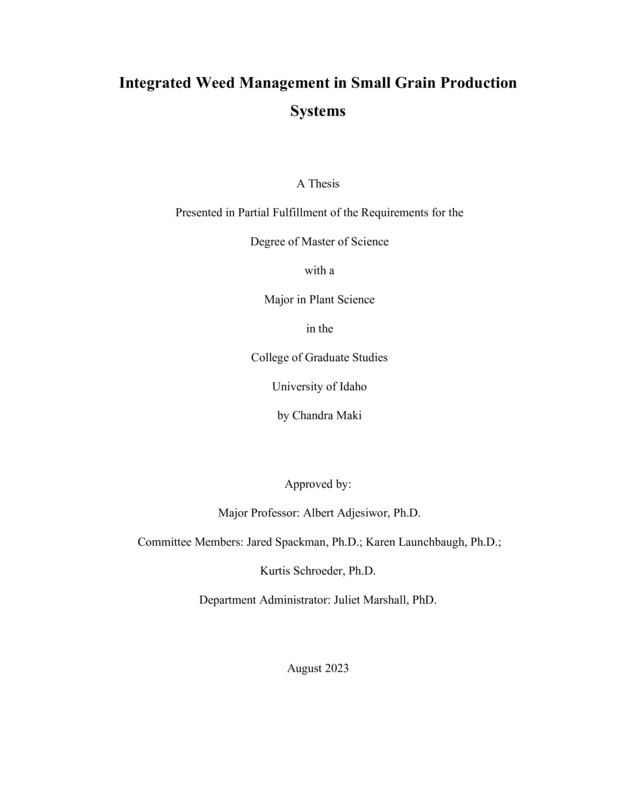Integrated Weed Management in Small Grain Production Systems
Maki, Chandra. (2023-08). Integrated Weed Management in Small Grain Production Systems. Theses and Dissertations Collection, University of Idaho Library Digital Collections. https://www.lib.uidaho.edu/digital/etd/items/maki_idaho_0089n_12670.html
- Title:
- Integrated Weed Management in Small Grain Production Systems
- Author:
- Maki, Chandra
- ORCID:
- 0000-0002-8022-5263
- Date:
- 2023-08
- Program:
- Plant Sciences
- Subject Category:
- Plant sciences
- Abstract:
-
Small grain systems make up a large portion of Idaho's agricultural production, and just like any other crop, have weed pressures. Using different methods of weed control such as cultural, mechanical, and chemical has been proven to be an effective way to help control different types of weeds. The main objectives of this thesis project were to evaluate alternative pre-plant herbicides for weed control in small grains, 2) assess the use of herbicides and crop rotations for integrated weed management, and 3) evaluate weed control and weed pressure impacts on alfalfa, one of the most important rotational crops in small grain production systems. For chapter 1, a 2-year field study was conducted to evaluate the efficacy of alternative preplant burndown herbicide treatments as compared to glyphosate treatments, the industry standard. An economic analysis and crop injury observation were also conducted. Most herbicide treatments achieved 90% or more control of the predominant weed species. In the economic analysis, at least six different herbicide treatments were equivalent to the cost of glyphosate at $26.50 per hectare. No observable damage from herbicide treatments was present, and crop yield was not affected by the treatments. All these factors show that there are alternatives to preplant burndown that are just as effective as glyphosate treatments. With combinations of herbicides, each having a different site of action, weed control can be achieved while simultaneously reducing the risk of herbicide-resistant weeds spreading. For chapter 2, a 4-year crop rotation study was initiated in 2021 at the University of Idaho Kimberly Research and Extension Center to evaluate weed control and seedbank dynamics in wheat-alfalfa vs wheat-annual crop (corn and dry bean) rotations. There were three herbicide treatments: non-treated, postemergence (POST) only, and preemergence (PRE) + POST. After the first year, there was no difference in seedbank density among treatments. After two years, weed seedbank density was reduced from 2,227 viable seeds m2 in the non-treated to 1,344 seeds m2 in the PRE + POST treatments, representing nearly a 40% difference in seedbank density. There was also a trend of PRE + POST treatments slightly reducing weed seedbank density compared to POST-only treatment. Weed density within the crops during the growing season was influenced by the type of crop as well as the herbicide treatment. Both POST-only and PRE + POST treatments reduced weed density compared to the non-treated and the PRE + POST treatments reduced weed density in each crop compared to the POST-only treatment. Weed control treatments did not affect alfalfa yield. However, herbicide application (POST only and PRE + POST) improved corn and dry bean yield. The combination of fewer weeds and greater crop yield in the PRE + POST treatments holds promise for reducing weed seedbank and potentially improving long-term crop productivity and economics. In chapter 3, field studies were conducted in Idaho in 2021 and 2022 to evaluate the effect of weed control treatments on alfalfa forage accumulation, weed biomass, and nutritive value. In addition, the relationship between the proportion of individual weed species biomass and alfalfa nutritive value was assessed. These studies included eight different herbicide and herbicide combination treatments, including the non-treated check. Treatments were comprised of pre-emergence incorporated, early postemergence (after 80% alfalfa emergence), and postemergence (third trifoliate alfalfa) herbicide applications. Data collection included weed control efficacy, weed and alfalfa biomass, and alfalfa nutritive value. Additional samples were collected and combined in the following alfalfa to weed biomass proportions (% by weight): 0:100, 20:80, 40:60, 60:40, 80:20, and 100:0, for wet chemistry analysis of forage nutritive value to evaluate the relationship between the proportion of individual weed species biomass and alfalfa nutritive value. The acetochlor-only treatment provided less than 50% weed control while the EPTC-only treatment provided 54 to 81% weed control. The control provided by acetochlor and EPTC were less than treatments containing imazamox and imazamox plus bromoxynil. Weed biomass in forage (23 to 55% of total biomass) due to poor or no weed control reduced crude protein, increased fiber concentrations, and reduced the relative feed value. The relationship between the proportion of individual weed species biomass and alfalfa nutritive value was linear for all weed species evaluated.
- Description:
- masters, M.S., Plant Sciences -- University of Idaho - College of Graduate Studies, 2023-08
- Major Professor:
- Adjesiwor, Albert
- Committee:
- Launchbaugh, Karen; Schroeder, Kurtis; Spackman, Jared; Marshall, Juliet
- Defense Date:
- 2023-08
- Identifier:
- Maki_idaho_0089N_12670
- Type:
- Text
- Format Original:
- Format:
- application/pdf
- Rights:
- In Copyright - Educational Use Permitted. For more information, please contact University of Idaho Library Special Collections and Archives Department at libspec@uidaho.edu.
- Standardized Rights:
- http://rightsstatements.org/vocab/InC-EDU/1.0/

